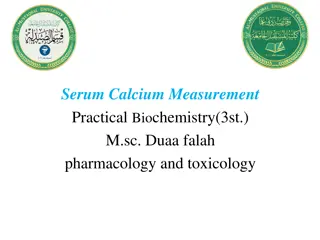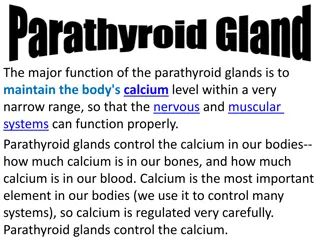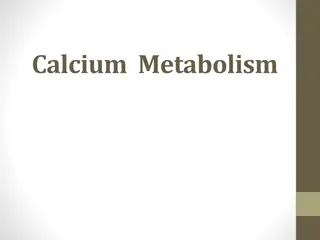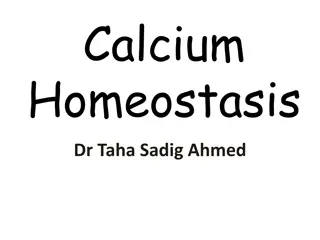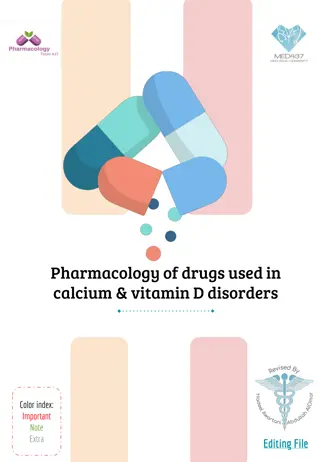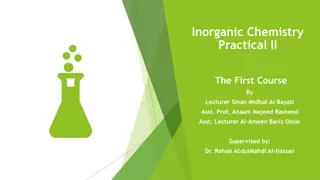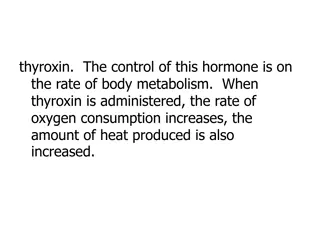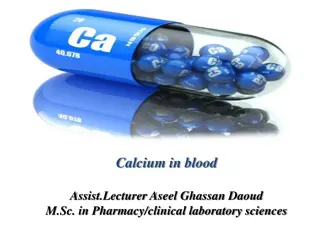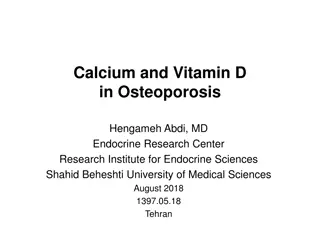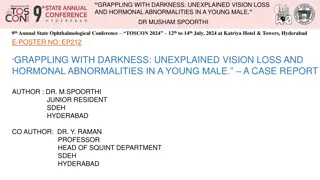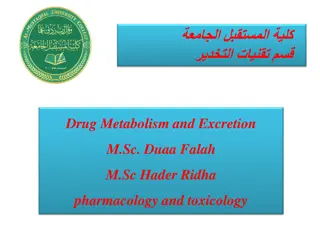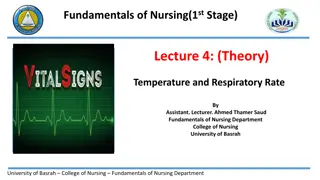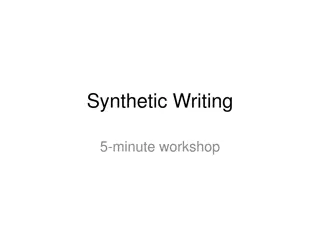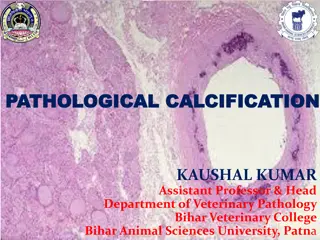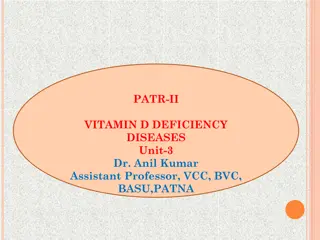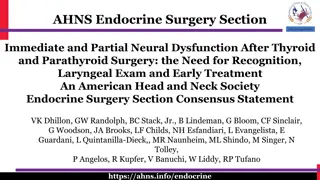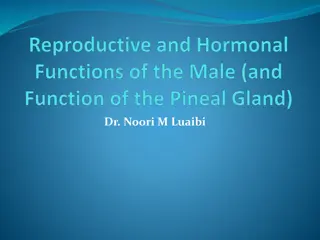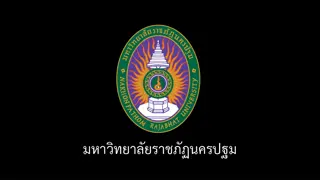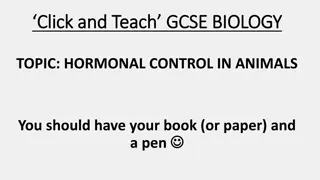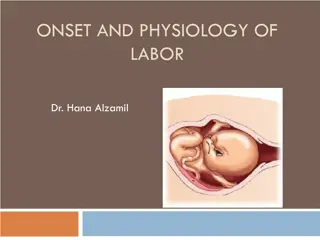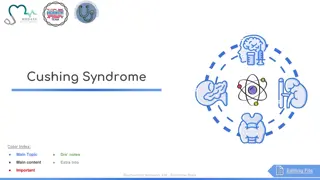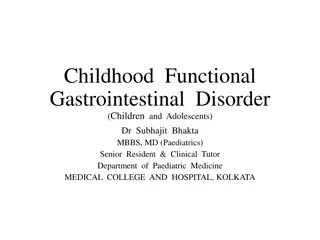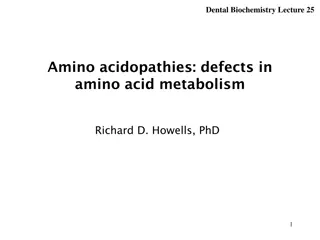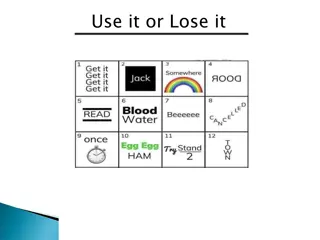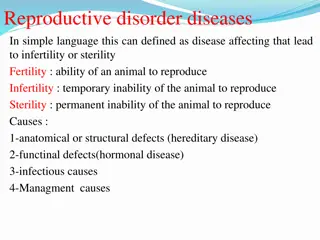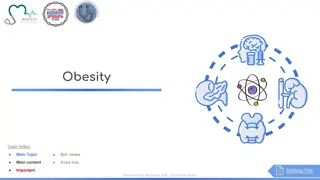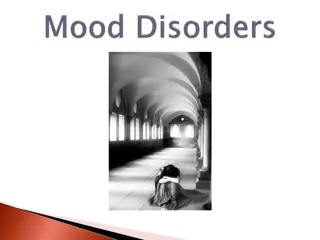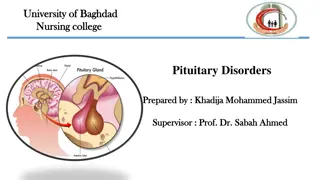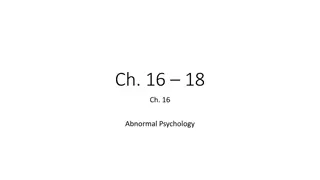Understanding Parathyroid Disorders - Calcium Metabolism and Hormonal Regulation
This presentation covers the functions of calcium, calcium metabolism, bone physiology, and hormonal regulation of calcium metabolism focusing on parathyroid hormone, calcitonin, and Vitamin D. It discusses hypo and hyperparathyroidism in detail, including clinical manifestations and treatment options. Additionally, it addresses hypercalcemia and hypocalcemia, along with their causes and clinical signs.
Download Presentation

Please find below an Image/Link to download the presentation.
The content on the website is provided AS IS for your information and personal use only. It may not be sold, licensed, or shared on other websites without obtaining consent from the author. Download presentation by click this link. If you encounter any issues during the download, it is possible that the publisher has removed the file from their server.
E N D
Presentation Transcript
Text Only in Females slide Only in Males slides Important Numbers Doctor notes Extra Notes . 1
Hypo and hyper-parathyroidism By the end of this lecture, students should be able to describe: 1. List the functions of calcium. 2. Describe calcium metabolism. 3. Describe physiology of bone. 4. Understand and explain hormonal regulation of calcium metabolism: A. Parathyroid hormone B. Calcitonin C. Vitamine D3 5. Understand hypo and hyper-parathyroidism. 2
Only in Males Slides Hypercalcemia PTH mediated: Primary hyperparathyroidism. Clinical Manifestation: Non-PTH mediated: Parathyroid hormone related peptide (PTHrP): certain tumors secrete high levels of PTHrP, which causes hypercalcemia of malignancy. Nausea, vomiting. Anorexia (decrease apatite), weight loss. Constipation. Lethargy (tiredness )and Fatigue. Confusion, stupor (lack of critical mental function), coma. Impaired concentration and memory. Depression. Reduced neuromuscular excitability & muscle weakness (calcium blocks sodium channels and inhibits depolarization). Easy fatigability & muscle weakness more common in hyperparathyroidism than other hypercalcemic conditions. Proximal muscle weakness Shortened QT interval on electrocardiogram. Cardiac arrhythmias. Vascular calcification. Vitamin D intoxication, granulomatous disorders, osteolytic bone metastases, malignancy. Medications: Thiazide diuretics NS (normal saline) bolus to restore volume; then 100 200 ml/hours. Bisphosphonates (onset 24 - 48 hours). Calcitonin 4 8 IU q6-8 hrs (onset immediate, resistance develops in 24 - 48 hours). Surgery for adenoma. Medications of severe hypercalcemia: Indications for therapy: Symptoms of hypercalcemia & Plasma [Ca] >14 mg/dl. Principles of therapy: Expand ECF volume. 1. Increase urinary calcium excretion. 2. Decrease bone resorption. 3. 3
Only in Males Slides Wolff s Law States that bone in a healthy person or animal will adapt to the loads under which it is placed. If loading on a particular bone increases, the bone will remodel itself over time to become stronger to resist that sort of loading. The remodeling of bone in response to loading is achieved via mechanical stress. Prolonged immobilization might lead to bone resorption and increased calcium plasma levels. 4
Only in Males Slides Hypocalcemia Causes: Clinical Signs: Hypoparathyroidism: Neuromuscular excitability. Surgical (thyroid, parathyroid surgery). Paranesthesia (tingling sensation) around mouth, fingers and toes. Autoimmune Muscle cramps, carpopedal spasms (a spasmodic contraction of the muscles of the hands, feet, and especially the wrists and ankles). Magnesium deficiency Tetany (is a medical sign consisting of the involuntary contraction of muscles). PTH resistance (pseudohypoparathyroism): Normal PTH levels but deficient receptors Seizures (focal or generalized). Vitamin D deficiency Laryngospasm (an involuntary muscular contraction (spasm) of the vocal folds), stridor (is a high-pitched breath sound) and apneas (suspension of Vitamin D resistance breathing) this signs appears in neonates. Lack of 1 hydroxylase no vit D3 activation. Cardiac rhythm disturbances (prolonged QT interval). Other: renal failure, pancreatitis and tumor lysis. Chvostek s and Trousseau s signs latent hypocalcemia (explained next slide). 5
Very important Chvostek s & Trousseau s sign Chvostek s Sign Trousseau s Sign To elicit the sign, a blood pressure cuff (sphygmomanometer) is placed around the arm and inflated to a pressure greater than the systolic blood pressure and held in place for 3 minutes. It refers to an abnormal reaction to the stimulation of the facial nerve. When the facial nerve is tapped at the angle of the jaw (i.E. This will occlude the brachial artery. Masseter muscle), the facial muscles on the same side of the face In the absence of blood flow, the patient's hypocalcemia and subsequent neuromuscular irritability will induce spasm of the muscles of the hand and forearm. will contract momentarily. Typically a twitch of the nose or lips because of hypocalcemia. The wrist, thumb and metacarpophalangeal joints are flex, and fingers are adducted. This is due to enhanced neuromuscular excitability. 6
Only in Males Slides Hyperparathyroidism The disorder is characterized by: Causes: hypercalcemia, hypercalciuria, hypophosphatemia, and hyperphosphaturia. Primary Adenoma (90%). Parathyroid hormone causes phosphaturia and a decrease in serum phosphate. Multiple gland enlargement (10%). Familial hyperparathyroidism. Calcium rises and it is also secreted in the urine. Carcinoma (<1%). Familial benign hypercalcemia (FBH). Most common complication are renal stones made of calcium phosphate. Secondary (normo - or hypocalcemic): Stone chemistries: calcium, phosphate, urate. Renal failure. Most serious complication is the deposition of calcium in Vitamin D deficiency. the kidney tubules resulting in impaired renal function. 7
Cont. Here the diagram explains the parathyroid hormone functions: 1st on bones: increase Ca++ and Phosphate resorption. 2nd on kidneys: Increase Ca++ reabsorption, However it increases phosphate excretion. Also it stimulate (enhance) the action of 1- - dihydroxycholecalciferol enzyme which will increase the production of 1,25(OH)2D3 the active form of vit D. Ultimately this will lead to increase Extracellular fluid Ca++ and decreasing Phosphate. 8
Primary Hyperparathyroidism Only in Females Slides Only in Males Slides Just read it Manifestation: Hypercalcemia, Hypercalciuria. Hypophosphemia ( PO-4) Affects approximately 100,000 patients a year (in Alkaline phosphatase (steoclastic resorption of bone can lead to weakened bones the US). and secondary stimulation of the osteoblasts When the osteoblasts become active, they Prevalence: 0.1 to 0.3% of the general population. secrete large quantities of alkaline phosphatase.Therefore, one of the important diagnostic findings in hyperparathyroidism is a high level of plasma alkaline phosphatase). More common in women (1:500) than in men Demineralization of bone multiple bone cysts (osteitis fibrosa cystic). (1:2000). Broken bones. Patients with single adenoma ~90% : minimally CNS depressed, peripheral nervous system depressed (because of high Ca in ECF will decrease Na permeability at NMJ) invasive surgery. Muscle weakness. Constipation, abdominal pain, peptic ulcer & decrease appetite. Depressed relaxation of the heart during systole. The bone becomes weak and easily broken. Calcium containing stones in kidney. Parathyroid poisoning: Precipitation of calcium in soft tissues occur when Ca+2 >17mg/dl lead to death. If we measured the level of the enzyme alkaline phosphatase in blood it will be high. 9
Only in Females Slides Secondary Hyperparathyroidism Due to Ca+2 in ECF. Causes: Low calcium diet. Pregnancy. Lactation. Rickets or Osteomalcia. Chronic renal failure 1,25(OH) D3 synthesis 10
Important Hypoparathyroidism (Rare) Signs: Cause: Positive Chvostek s sign (facial muscle twitch). Positive Trousseau s sign (carpal spasm) metacarpophalangeal and wrist joints are flexed, fingers are adducted. Delayed cardiac repolarization with prolongation of the QT interval. Paresthesia. Tetany: can be overt or latent. Injury to the parathyroid glands (surgery). Autoimmune. Symptoms: (due to hypocalcaemia) Tingling in the lips, fingers, and toes (Due to neural hyperexcitability). Treatment: Dry hair, brittle nails, and dry, coarse skin. Calcium carbonate and vitamin D supplements (We can t treat the patient with parathyroid hormone since its effect is transient and very expensive) Muscle cramps and pain in the face, hands, legs, and feet. Case: Cataracts on the eyes (No one knows why). 27 years old man present to his physician 3 weeks after his thyroid surgically removed Malformations of the teeth, including weakened tooth because of thyroid cancer, he noticed after discharge that he has involuntary painful muscular cramps, numbness around his mouth, head and feet, his parents said that he was irritable for enamel. the the last 2 weeks and he is on levothyroxine medication. Loss of memory. Diagnosis: Headaches. Hypoparathyroidism due to injury of the gland during the surgery 11
Important Vitamin D deficiency Diseases 1. Rickets: (in children) Cause: lack of vitamin D leading to calcium/phosphate deficiency in ECF, so there is normal formation of the collagen matrix but Incomplete mineralization (poor calcification) Soft Bones (Clinically: Bone Deformity). (Either due to low VitD. intake or insufficient sun exposure calcium & phosphate in ECF no bones calcification soft weak bones the weight of the body will cause the bones to bend) Season: Occur in the spring. Why? due to depletion of VitD stores during the winter so symptoms appear in spring. . Features: Tetany in Rickets (only in females slides) Low plasma calcium & phosphate. 1. No tetany. Weak bones Tetany as compensatory mechanism 2. Early stages PTH stimulate osteoclastic absorption of bone. 3. ECF Calcium level is normal. Rickets . PTH When the bones finally become exhausted of calcium Calcium level falls rapidly Treatment of Rickets: Blood level of calcium falls below 7 mg/dl Signs of tetany: positive Chvostek's sign. Supplying adequate calcium and phosphate in the diet. 1. Death: tetanic respiratory spasm. Administering large amounts of vitamin D. 2. 12
Cont. Only in Females Slides 2. Osteomalacia: (Rickets in adult) 3. Osteoporosis Typically silent without symptoms until late stages fractures with minimum trauma. Demineralization (poor calcification) of preexisting bones Inadequate bone matrix and minerals. which leads to more susceptibility to Fracture. Osteoporosis is the most common of all bone diseases in adults, especially in old age. Serious deficiencies of both vitamin D and calcium occasionally Results from equal loss of both organic bone matrix and minerals resulting in loss of total bone mass and strength. occur as a result of steatorrhea (failure to absorb fat) (Since vitD is fat soluble it can be deficient in cases of steatorrhea). The cause of the diminished bone: Poor absorption of vitamin D and calcium. The osteoblastic activity in the bone is usually less than normal so the rate of bone osteoid deposition is depressed. Almost never proceeds to the stage of tetany but often is a Excess osteoclastic activity. cause of severe bone disability. Lack of physical stress. Renal Rickets: (The kidneys synthesize the active form of VitD Malnutrition (lack of vitamin C) collagen decrease. Only in Females Slides since it contains the enzyme 1-hydroxlase) Postmenopausal lack of estrogen (Estrogen inhibit the activity of osteoclast and decrease the number of osteoclast. So, when estrogen gone the osteoclast will start to do it s function) It is a type of osteomalacia due to prolonged kidney Old age. disease. Cushing s syndrome (because massive quantities of glucocorticoids secreted in this disease cause decreased deposition of protein throughout the body and increased catabolism of protein and have the specific effect of depressing osteoblastic activity). Failure of the damaged kidney. 13
Summary 14
Thank you for checking our work! . Please check our editing file to know if there are any additions, changes or corrections. : & Examine yourself : 2017-2018 Dr. Abeer AlGhumlas s Lecture & Notes. 2017-2018 Dr. Khalid Al Regaiey s Lecture& Notes. Guyton & Hall of Medical Physiology 13th Edition. Linda S. Costanzo 5th Edition. Helpful physiology bocks. Give us your feedback 15 .


